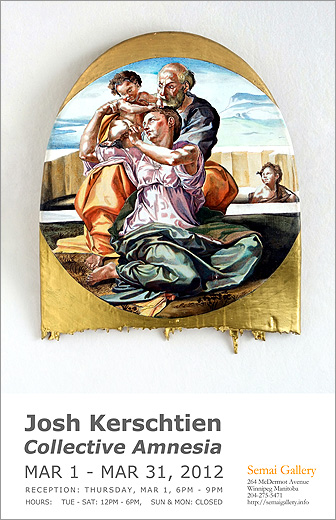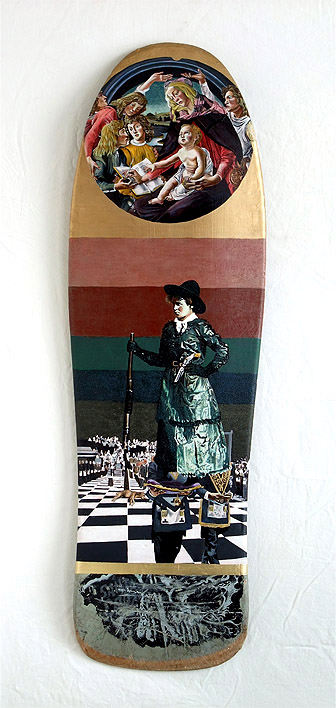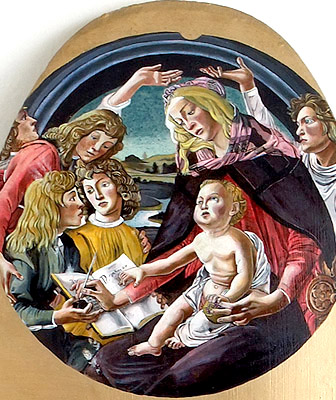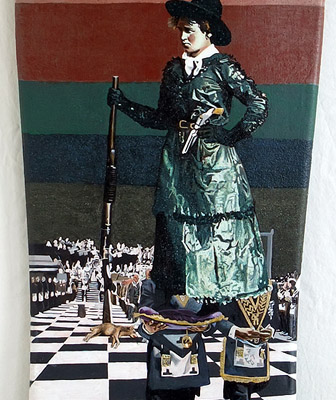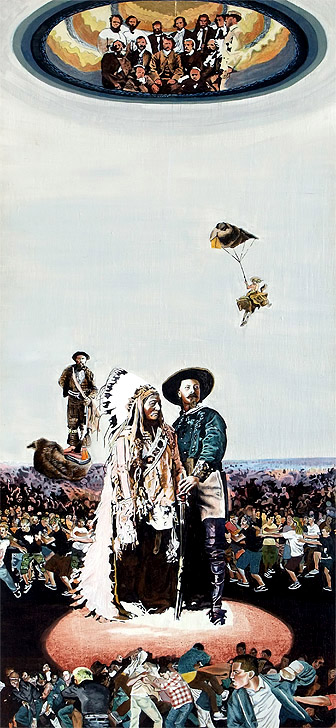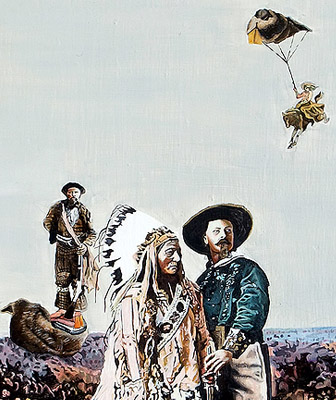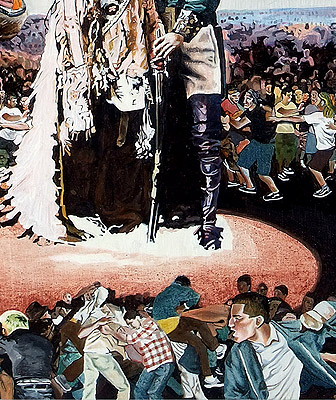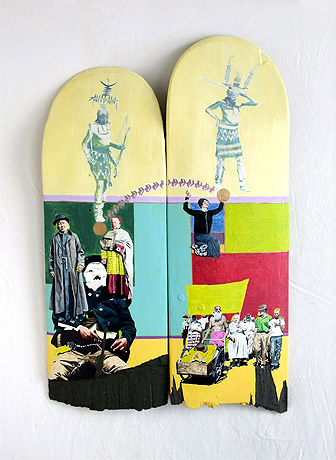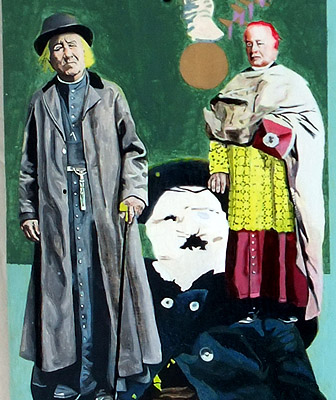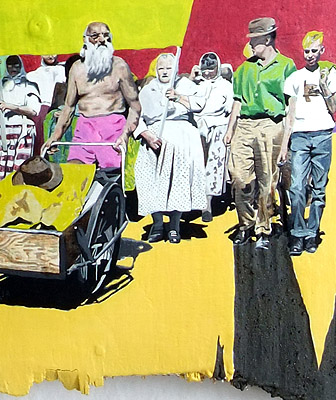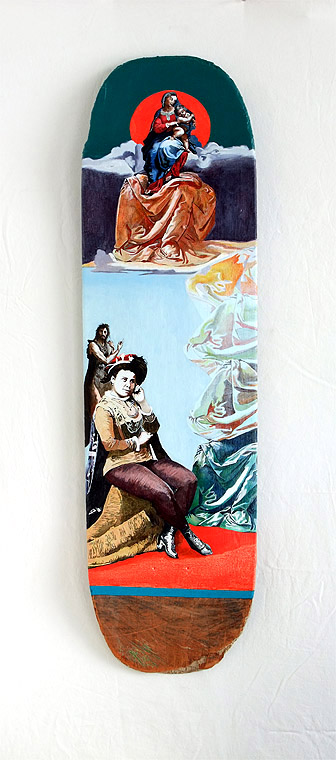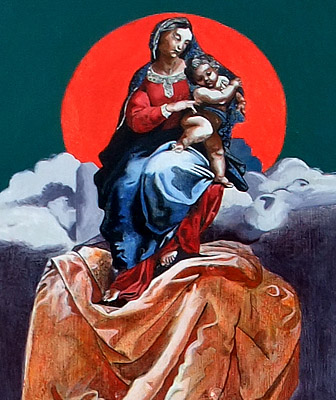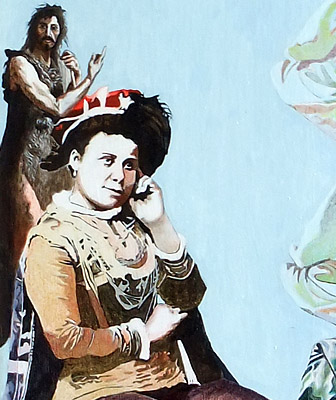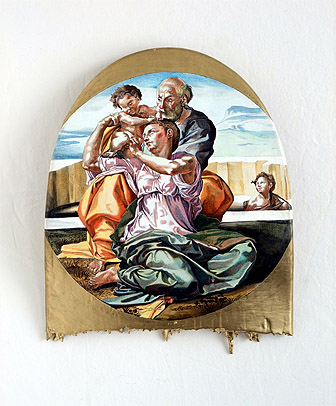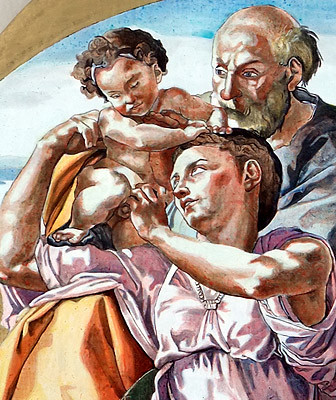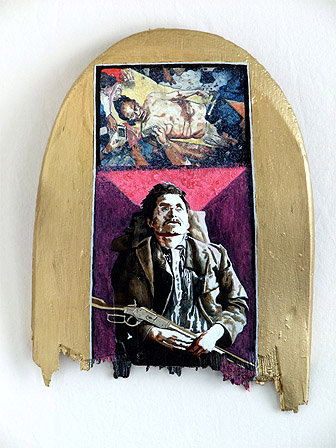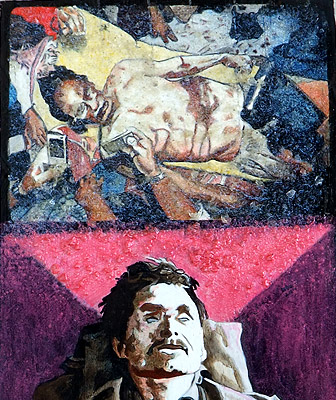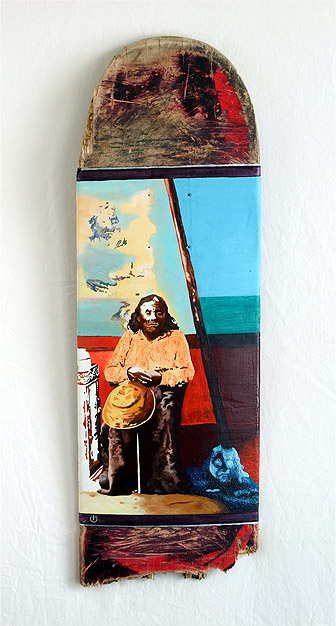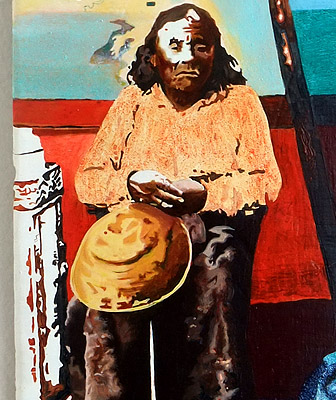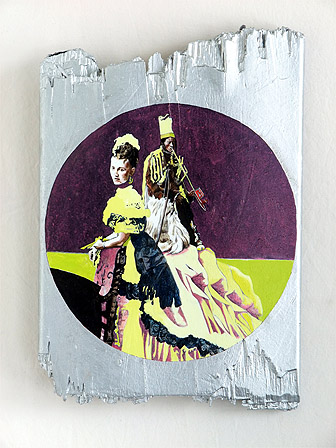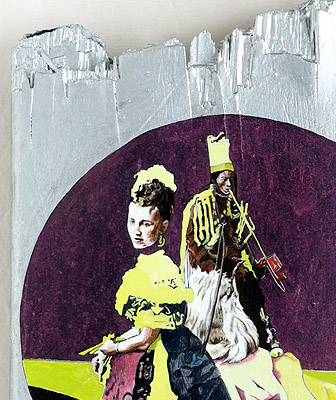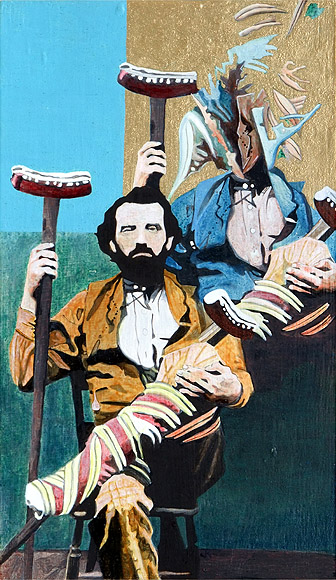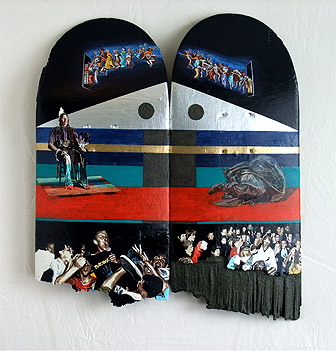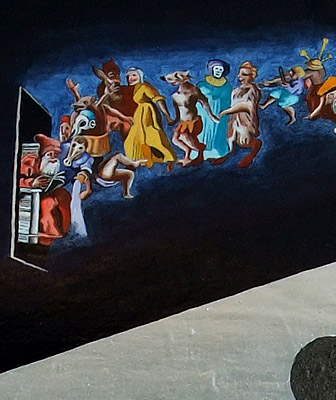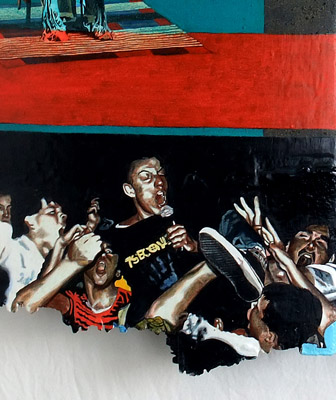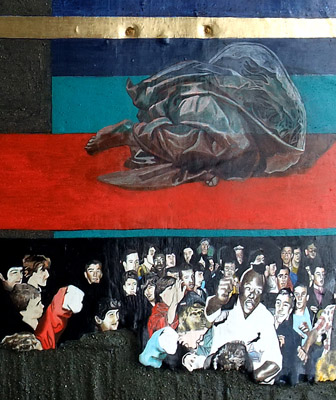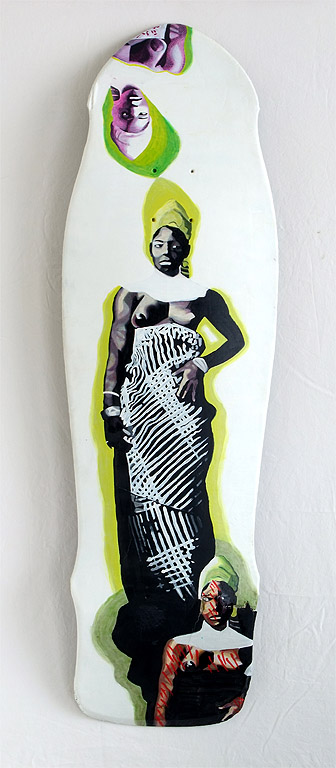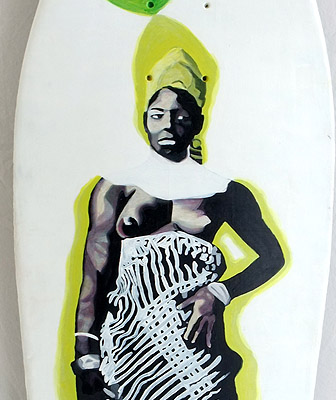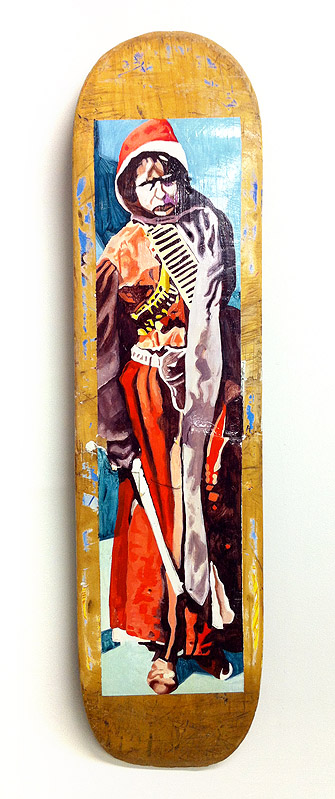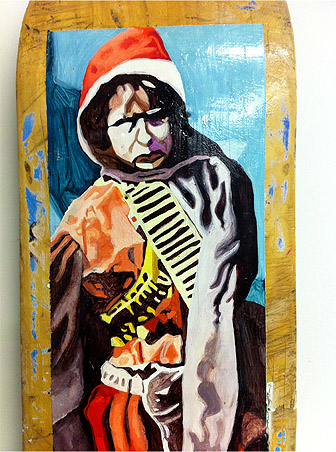| Schedule | About | Exhibitions | Press | Submission | Links | Contact |

|
|
March 1 - March 31, 2012 Josh Kerschtien Collective Amnesia Opening Reception: Josh Kerschtien Winnipeg, Manitoba, Canada
E-mail: joshuakerschtien[at]gmail.com Statement / Descriptions
All written by Josh Kerschtien Download statement / description in PDF Collective Amnesia Collective Amnesia (CA) is an expose of memory erosion in the human geographic landscape. Encompassing history, ritual and revolution, paranoia of catastrophe and communication in the hyper digital age, this series explores traumatic stress as the unifying force. CA attempts to deconstruct knowledge in order to spark dialog of the turbulent past and the inevitable present. What happens to oral societies when their stories are lost? World catastrophes may influence religion, thus its traumas echo throughout the ages in the form of rituals. Do past act of rebellion influence present sub-cultures? Does the over stimuli of violence in media differ from the Wild West? The majority of the paintings use old broken skateboards. These items had lost their functional use to become substrates in the series. Found in skate parks, riders abandoned and forgot them. The deformed surfaces serve as an explanatory backdrop to project a world view of CA. Figurative in nature, the paintings imbue the Symbolist style of the late 1800's to early 1900's, using Renaissance influences. Minerals were gathered and hand ground to be used through the series. Painters of the early eras used these minerals in the original pallet, but recently synthetic pigments have replaced them, another product of CA. Coyote Coyote takes place during a Freemason ritual. A Mason holds a pillow while a proud women leans on a shotgun, and a coyote lies dead at the butt of the gun. She hides the two masons, which represents the secretive nature of Freemasonry. Bars of mineral pigment are used rising towards a Renaissance painting of Mother Mary and Jesus. They are surrounded by gold with calm faces and comforting gestures, while aligning with the mineral bars below. This alignment illustrates how old knowledge can be new knowledge and how history is quickly diminished. The proud woman's feet hover above the pillow. The composition of the Freemason ritual is illusively present and indicative of its absurdity, yet rituals continue today. The gun is an unconscious fear of mass extinction, the force of mediation in the ritual. Due to overpopulation, and conflicts with human settlement, coyotes currently have bounties on their heads in Saskatchewan and other parts of Canada. This is a microcosm of the human geographic experience in the contrived fearful world we live in, with the gun as a symbol of nature. Circus Pit At the top of the painting Circus Pit, a heavenly circle opens over a gloomy prairie scene. Louis Riel and the Metis Provisional Government of 1869 are seated in the hole in the sky. In the bottom middle, Sitting Bull and Buffalo Bill pose in large scale while surrounded by a hardcore punk circle pit. Gabriel Dumont crowd surfs on a big beaver jaw. Louis Riel's rebellion greatly influenced the social development of North America. He died a martyr and is revered today. Buffalo Bill's Wild Wild West circus-esque show travelled much of the land starring Gabriel Dumont and Sitting Bull. In the historic past, rebels were celebrities much like the early 1980's hardcore punk movement questioning an over indulgent society. Colonization's trauma of indigenous cultures of the past further echo's in the hyper digital age. Buffalo Bill co-opted Napoleon's style to promote his travelling show, similar to the current music industry's popularization of hardcore and punk music sub-genres, which have gone through waves of interest, thus the original morals and music have changed. The flying horse and women is reminiscent of the Valkyries, and was used through Buffalo Bills advertising. Her kite is the top portion of the beaver head which interlocks with the beaver jaw in which Gabriel Dumont crowd surfs. The idea of rebellion is romanticized and profited from thus losing its original semantic potency. Rebels and terrorists become celebrities and trends in the CA. Fact or Fantasy Math and color are used in square composition to represent North America in the painting Fact or Fantasy. Utilizing pop and iconic art styles the painting is set up in a directional composition North, South, West and East. An esoteric equation called the Golden Ratio makes up the North American backdrop consuming the majority of the image. The Ratio was used in ancient and modern architecture. Monolithic structures such as the Pantheon in Greece and the Great Pyramid in Giza used this Ratio extensively and it has continued to be used in modern architecture such as the Manitoba Legislative Building in Winnipeg. Colors in the square box relate to pop culture, religion, medicine and education; further instilments that represent North America. Ghost Dancer stands above "the box" facing the rising sun in the East. Stereotype colors are used to appear ghostly. In the East a Dancer steps on a gold disc emanating an electro-magnetic charge, arching to a corresponding disc on the West. An Evangelist woman from the 1970's catches the disc, her hand just leaving "the box". The electro-magnetic discharge is the unity of fantastical ideas and the rising and setting of the Sun is the fact based reality, set up to alter and change. Below in the Southeast a group of Doukhobors protest, leaving "the box" towards the West. The Doukhobors were a Russian Spiritual Christianity splinter sect which originated in the 17th century. Their spiritual convictions led them to protest against the Orthodox Church and the Russian Imperialist government - their defacement of many icons in churches was one example of their pacifist but rebellious expression. This led to their massive exile out of Russia to Canada and the United States. One may assume the spirit wrestler draws similarities to the pacifist hippy movement and the pop colors in the background pays homage to them. Stage coach robberies were the most thrilling event to plaster the newspapers in the late 1800's. In the South West of Fact or Fantasy sits a famous highway robbery during the 1870's. On his shoulders stand two religious icons subtly defaced; relating to the icon wrestlers in the parallel East. Chalkboard with translucent repetitions of the alphabet, cradle the religious icons with Highway Man, a symbol of moral absurdity. At the bottom the broken cracks of the skateboard are painted using crushed copper mined from Flin Flon, Manitoba, in the 1950's. Overall the painting uses four different mineral pigments-Azurite, Malachite, Copper and Mica- all making up the two Ghost Dancers. The minerals used are the notion of historical facts becoming imaginary overtime, and the endless pursuit for Fact or Fantasy. God and Natural Disasters The main feature is a woman from the Yukon's Klondike Gold Rush era sitting proudly. The draped legs repeated on the right side are a reference to Da Vinci's studies on folds in clothing. The top and bottom legs are full in form while the middle ones are abstracted. The Mother Mary and Jesus and a vermillion sphere flow on the top draped legs while the bottom glows the same brilliant hue. The Klondike women parallels the "hipster" generation in fashion taste. She connects to the present content and unaware of altering calamities. The peasant in the background inquisitively points towards to the sky with a complacent stare. The peasant and Mother Mary and Jesus are derived from Raphael's, two famous Renaissance icons. God is symbolized by the legs the others rest on famous Renaissance icons. In the bottom, the aqua blue legs and vermillion ground relate to fire and water. The subtle ether of the legs transfer upwards, like the evaporation of memories and the recycling of ideas as time moves forward. Melting Gold Melting gold is a Renaissance replica of Michelangelo's painting The Holy Family. This piece is painted on a broken snowskate (a new sport merging snowboarding and skateboarding) nose. The image is surrounded with a gold pigment, with the broken bottom edge appearing as melting gold. Associating art history aesthetics and modern culture, this work reverberates the past and present. The boarder relates to gold being forged into something different (i.e. fragment board). Piezoelectric Bandits In the 1800's and early 1900's, executed criminals were commonly displayed as hunting game in public venues. In Piezoelectric Bandits a criminal is shown dead with his gun cradled in his arms. His body is positioned to appear alive. At the top is a square tablet of a cellular phone projecting unnatural light on the bandit. The tablet is a major tool and product of the hyper digital age. It depicts Gadhafi after his execution and the subsequent broadcast gone viral. The image of Gadhafi is distorted by crushed quartz crystal, an early and important component used to stabilize frequencies in radios and keep track of time in watches. The image is surrounded by gold referring to a shrine type image. The two displays may assume parallel ideas of closure to atrocities committed. Are the majority desensitized to these morbid archetypes? Is displaying defeated villains a coping mechanism, cynical entertainment or simply propaganda? Posters Posters deals with information in a highly technological age. History fragments and then weaves into a new reality, quotes from the past drift into the present embedding into pop culture hence Posters. The central figure is Chief Seattle, a Squamish leader. The solemn image represents his only known photograph, his physical memory. The top left illustrates the life and struggle of the 1860's to 1880's. At the bottom right, more details of Chief Seattle's face are shown with a crystallization effect represented in multiple layers of raw minerals. This all correlates to upheaval today. iPod borders instil a modern hold on tech-aesthetic, thin silver lines and black/red purple bars not unlike many gadgets. The bottom left shows an on-off switch illustrating the notion of a world able to choose its traumas to stress about. Repetition City Lights Repetition can be used to identify with the past. Different outlooks on life, tastes in fashion have stereotyped older times and cultures. A bustle is a framework expanding the drapery in the back of women's dresses (used in the 1860 - early 1900's). An aristocratic woman glances awkwardly to the viewer, her bustle repeated four times, creating a support, or ledge. On the bustle ledge sits a Native American, pose in as many Native stereotyped props on hand during the photos original shoot. One may say these are "normal" images of people from 100 years ago. Purples in the background hint to light pollution from modern towns and cities. Yellow-green runs through the woman's dress and shaman's wardrobe. Parcelling glow sticks often seen in raves and music events. The subtle use of color tweaks points to an easy acceptance and categorization of people and events. Our current time will be in the same boat in the future, a stereotyped version in the CA. Scattered Parts Robert Clay Allison, a Texas gun fighter and cattle rancher, was a well known historic figure in the American Old West. He suffered from personality disorder, epilepsy and manic issues. The mood swings gave way to his notoriety.Allison sits with a crutch and bandaged foot, a catastrophe from a gunshot inflicted during a game of "make him dance." The image is repeated in double manner, one representation and the other leading to abstract reality. The upper right figure is a face composed of different parts creating a scattered effect. Based on his Civil War discharge report, Allison's mental issues came from past head trauma thus creating a mythic figure in the Old West. Gold symbolizes the iconic character of madness rippling throughout the pages of history. The recent events of Charlie Sheen clearly show the collective conversation of mental illness. One may consider the Charlie Sheen event as a modern counterpart to Clay Allison. The Abyss Abyss upon abyss; each level leaves an imprint of the past. Moving forward are fresh stains of the present. The Abyss is imbued with generation gaps. As technology advances and entertainment evolves, generations have drifted further from one another.The colour bars refer to a distant past, a gap between ideal and the abstract. In the middle left, a Native American poses in stereotypical wardrobe while hovering on a flying carpet. The pigment washed over his form symbolizes a forgotten issue. His hand, surrounded by a large silver pyramid, is a reminder to move forward and have hope. On the right, is a apparition of Mother Mary's legs in the painting Melting Gold and a dissected heart, together manifesting a broken heart. This is an analogy of trauma: a constant filament in the cultural unconscious. The theme of the bottom portion of the Abyss is clarity of mind. A straight edge band plays for a mangle crowd of kids. The movement was a punk subculture reaction to immorality in the late 1970's and early 1980's. At the top, two corresponding iPods face each other. An arch of people parade across the work while engaged in self-pleasures. The image is a reference to a medieval woodcut witchcraft propaganda highlighting the timelessness of hedonism. The silver pyramid links the generation gaps. The silver lining represents the social elation ascending with the rising apex of technology. Contemporary generations forget due to current music, fashion and politics. Copper is utilized again in the broken skateboard parts, a funnel in the middle of the color bands and two circles in the silver pyramid. Copper represents a person, jagged and broken at the bottom right. A cohesive sharp rectangle forms, cutting through the colour bands and forming two holes in the pyramid. This is the change when new thoughts form and holes see into the Abyss. Upside-Down Thought Forms Upside-Down Thought Forms (UTF) touches on mental illness due to traumatizing events. Using colour relationships, repetition, patterns and open composition. UTF offers hope when all is slipping away.An African Women takes up most of the composition, her bust being repeated 2 times, in the bottom right and top left. The bottom persona represents a negative mindset. A crack in the skateboard is exploited to enforce a physical trauma; the face painted within it to create an almost 3-dimensional illusion. Red marks on the woman's body are out-lashes of anger, natural reactions to shocking events. An outline of brownish green color envelopes portions of this persona. This color is a metaphor to encase these unstable emotions. The main figure stands strong and proud. Her confident pose is enlightened by a yellow aura suggesting intelligence due to her traumatic past (yellow merges with brownish-green in the bottom). The black garment she wears flows downward, enshrouding the bottom figure. Her dress is an embodiment of her burden the past shock; the whit patterns are symbols of a reconstruction of the self. Her head is surrounded with a yellow halo, touching the upper persona of the painting. The upper figure is coloured with bright greens and magentas. This figure is upside down, referring to an alternate perspective to the past and present state. This persona symbolizes the ability to move forward, after scarring events. It is the idea of hope, which rules the woman's confidence. Zapatista Warrior An unnamed female Zapatista warrior is depicted. (Led by Emiliano Zapata from 1910 until his assassination in 1919, the Zapatistas were a Mexican revolutionary force who fought for human rights.) The woman is squeezed on the skateboard with a disgruntled look. She appears to want to lunge out to the viewer, an illusion utilized in the physical crack of the skateboard. The Zapatistas were somewhat unique in that they used female warriors. There are other historical examples of female warriors such as Athena, the goddess of wisdom, law and justice, just warfare, strength, strategy, inter alia. In some ways the unnamed Zappitista warrior is an homage to Athena. The crack in the skateboard, parallels the birth of Athena from a crack in Zeuss' head. Athena was born fully armoured, and the combat gear of the Zapista woman is representative of this armour -- a ripple in CA. |
|
||||||||||||||||||||||||||||||||
